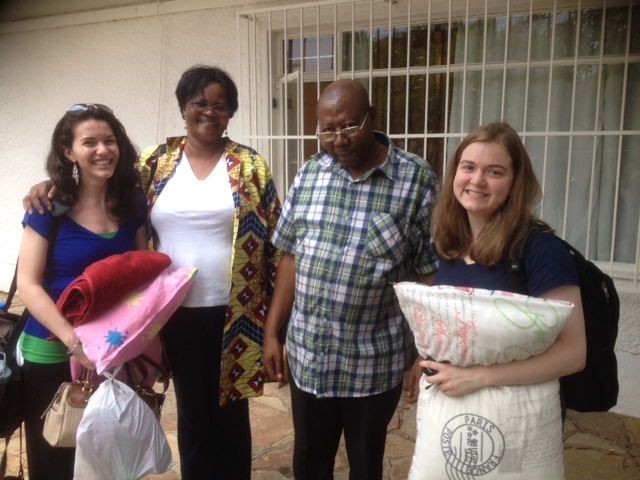While we had a quiet weekend of grading, reading/ planning and sightseeing (China town, the Namibian Indepence Museum, the gardens of Parliment and a couple of awesome restaurant experiences), we were always aware of our cell phones, feeling a little like "empty-nesters" while students were being immersed in the culture in another way - living with families to experience everyday Namibian life.
The CGEE staff does a wonderful job setting up this opportunity. (Thank you Sarah, Attila and Linda.) They interview families, visit their homes, explain the rules, and met with the parents Tuesday night to finalize everything while we were still en route. Many of these folks have done this many times before. There was also an orientation for students to let them know what expect, how to dress, and what to do in case of emergency, etc. They reported being both excited and anxious as they packed a weekend bag and awaited the arrival of their families.
It was exciting to see the families come one by one to claim "their children" for the weekend. Some students waited on the balcony watching for cars to slow as they approached the CGEE house. Others were in their bedrooms listening for their names to be called. It was really heartwarming to meet members of the families - sometimes dad, or mom, brother, sister or various combinations - all with ready smiles, handshakes or hugs (see pictures in previous entry).
What leaps of faith on both sides. Families opening their homes. Students, their curiousity. Both opening minds and hearts. Willing to be ambassadors to challenge stereotypes and build relationships that may continue long after this weekend.
Here are some of the students' testimonials:
'The immersion aspect of the home stay made our time in Katutura all the more amazing. Our energetic and strong-willed host mom made it a point to reveal to us the injustices that govern the living situation in Katutura. Placed so close to 'Silver town' (Informal housing), our stay constantly served as a reminder of how much of a contrast life is in Windhoek. The highlight of our adventures was being able to visit the Goreangab Dam where we caught an amazing view of the ruthless Namibian sun setting and leaving a wonderful array of colors. The homestay experience is nothing short of unforgettable'
- Nina and Nicole
Our homestay with The Madison family in Windhoek will definitely be a highlight of our study abroad experience. They went completely out of their way to make sure we were comfortable living in their home, yet they also made sure to push us out of our comfort zones and exposed us to some of their Namibian family traditions. They put us to work in the kitchen and taught us how to make some of their fabulous dishes they make regularly. We also got to attend their Sunday church service where we sang many songs and got to meet many of the locals. Fun fact: the president of Namibia can be spotted on most Sunday mornings! However, they also took us out to the local mall in town for a fun night of bowling. We had a lot of variety during our stay which we truly enjoyed, and will miss them dearly!
- Bri and Sarah T.
"Living with our Katatura host family was a wonderful opportunity to experience a piece of Namibian culture. We cooked together, attended a church service, and talked for hours about topics ranging from current political issues to the latest dance crazes. Our host family was incredibly kind and ensured we were both comfortable, yet adventurous in experiencing new foods and meeting new people. They also had a son whose energy was endless, which provided plenty of laughter and smiles. He was happy to teach us Afrikaans and demonstrate his best Kung fu. The hardest part was saying goodbye (and telling their son that, unfortunately, we didn't quite have room in our suitcases to bring him back to snowy Minnesota with us). This was definitely an experience we will remember."
-Kayla and Emily






















































